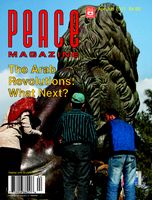
Peace Magazine Apr-Jun 2011, page 28. Some rights reserved.
Search for other articles by Shirley Farlinger here
A Man to Remember
Science for Peace will long be grateful for all the ways Dr. Terrell Gardner contributed to its birth and life.
Terry was a founder and first secretary/vice-president of Science for Peace and one of the editors of its first book, The Name of the Chamber was Peace. He was a member in 1980 of the small committee run by Eric Fawcett for “Directing Science toward Peace,” which was the forerunner of Science for Peace itself. He also joined, in December 1980, a small ad hoc committee that had been studying how to get peace studies established as a discipline at the University of Toronto.
No sooner had Terry joined this group than he proposed to present the concept to University College, whose council brought it into reality at its November 1981 meeting. This was the conception, if not quite the birth of the university’s endowed chair as well as its undergraduate and graduate programs in peace and conflict studies that lasted so many years at the college.
We begin Terry’s life story at the time he was employed by an insurance company as an actuary. His boss told him he would not advance in the company if he did not give up his knitted hat, his habit of whistling and his bicycle ride to work. He quit.
He took a Ph.D. at Columbia University in the branch of mathematics known as C-star algebras. It was Chandler Davis, his teacher and friend at Columbia, who persuaded Terry to come to the University of Toronto, one of few universities interested in C-star algebras.
There are elements of Terry’s life that reflect the upbringing he had as one of four children. Family gatherings were songfests of folksongs, Bach chorales and 16th to 18th century rounds. He, like his father, sang in choirs. He went on to sing in the Boston Symphony Chorus at Tanglewood, the Camerata Singers in New York and later the Toronto Chamber Society (now the Toronto Chamber Choir).
His wife Connie recalls Terry talking of how he and his sister would go the local dump where he would retrieve clocks and radios and take them apart just to see how they worked. From an early age he always wanted to “figure things out.”
Terry was in the US Navy during the war as an instructor in radar and sonar. After marriage and three daughters, his wife died of cancer. His second wife, Connie, who survives him, helped him raise the children.
In Toronto Terry became a pivotal force in sustaining Science for Peace and chairing a university-wide committee to establish a peace-studies chair. With sustained help from the University College principal, Peter Richardson, the committee and college raised half the necessary one million dollars.
When Anatol Rapoport retired prematurely (at age 72!) from the directorship of the Institute for Advanced Studies in Vienna, and returned to Toronto, Terry persuaded him to be the first professor of Peace Studies in a new program Terry directed. Rapoport accepted the Professorship without salary. Terry also brought Anatol into Science for Peace as a member, then board member, and as president, in May 1984.
Terry was also a promoter and the first convenor of the monthly Science for Peace lectures at the U of T. He was passionate about getting the best lecturers in peace issues to make contact with the public and with students.
Terry, as the education director of Science for Peace, attended the Canadian Network to Abolish Nuclear Weapons, a national coalition of peace groups. He also convened three inter-university workshops in peace education in which scholars from North America and Europe shared ideas on curriculum and procedures.
What did Terry do to maintain his energy for peace work? Connie thinks the bicycle and music were two ways he coped. Their trips took them throughout southern Ontario and Quebec, the New England states, Austria, France, wherever quiet roads were found in beautiful countryside.
His personal work habits are not ones to copy. His desk and office were a mess, he eschewed electronic media as long as he could, and he left much research unpublished. His interest was not in personal advancement or accolades. Getting credit was not important.
Connie recalls one high point in Terry’s life. He heard retired US General Lee Butler speak on the Cold War and of how horrified he (Butler) was by what he had learned about the nuclear threat through serving as a high-ranking officer. Butler thanked the peace movement for keeping the issues alive so that he could respond and people would know about them.
It was on the Internet pages of US Space Command that Terry found and decoded the language of US Space Command’s document Vision for 2020 and the US Government’s Long-Range Plan, with details of plans to dominate in and from outer space. Terry gave Vision for 2020 to CNANW and to Canada’s Department of Foreign Affairs, who took his material. Not many weeks later, as a result of much campaigning, Canadian support for Missile Defense was rejected in Canada.
I think there are things we can learn from Terry’s life: don’t worry about who gets the credit, just do it; connect with friends and mentors; never give up; don’t waste time stewing, just get busy; push the limits if you must; find a good soulmate, enjoy singing and whistling, wearing your old cap and bicycling; take time for wine, whiskey and good food.
By Shirley Farlinger

Peace Magazine Apr-Jun 2011, page 28. Some rights reserved.
Search for other articles by Shirley Farlinger here